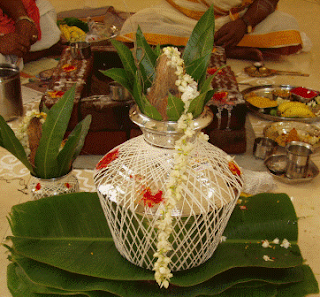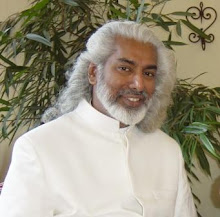
We use pots in our daily life for all kinds of purposes without thinking about it. But the humble pot carries deep meaning and symbolism in the doctrine and plays an important role in ritual and tradition. In Sanskrit the ritual pot is known as kumbha or kalasa.
Pots play a role in many different myths. This reflects the different aspects of the pot as a symbol expressing various meanings. Perhaps the most profound myth in which a pot plays a central role is the myth of the Samudra Manthana, the Churning of the Cosmic Ocean. The climax of this myth is the appearance of Lord Dhanvantari, the God from whom Ayurveda, the traditional Vedic science of healing originates. He rises from the Cosmic Ocean holding the pot with Amrita, the Divine Drink of Immortality in his hand. For this it was that the Devas and Asuras churned the Ocean of Milk.
Another important pot from mythology is the Kumbha holding the amrita and the seed of creation. In Kumbakonam in Tamil Nadu the entire landscape is sanctified by this myth of the pot carrying the Drink of Immortality and the Seed of Creation through the pralaya, the cosmic flood which ended the previous yuga. Various places and temples in and around Kumbakonam are associated with aspects of this cosmic pot. Finally Lord Shiva Kumbheshvara, the Lord of the Pot, pierced the pot with an arrow and the amrita and the cosmic seed spilled out, regenerating the cosmic cycle of creation. Today the place where the amrita flowed out of the pot is the Mahamagha Tirtha, a large and sacred water reservoir. Once in twelve years the water becomes once again the amrita, the divine nectar, the source of all life, and over a million people will come to bath on the auspicious time.
The astronomical time frames that designate and specify the auspicious time for the ritual bathing are connected to precession. The mythology that is expressed through the sacred landscape of temples, tirthas, vrikshas, mythology and ritual in and around Kumbakonam express precession and its ancient spiritual meaning. The sacred landscape and its mythology reflect the role of astronomy as a key to understanding ancient myth as is described and explained in Hamlet’s Mill.
The essence of the pot is of course that it can contain something. A full and complete pot is called purnakumbha. It represents abundance, completeness, wealth and prosperity. In a way it is a parallel to the horn of plenty of the western tradition. The purnakumbha is prepared according to doctrine with the thread windings, the coconut, the mango leaves and filled with water. It is given as an blessing and honor when rishis, saints, kings or ministers enter a temple. It is a symbolic gesture bestowing grace and abundance through the symbol of completeness, the purnakumbha.
But in the Vedic tradition the kumbha also performs the function of embodying the murti or form of the deity during a yajña, a Vedic fire sacrifice. Realizing the importance and the function of the pot in the doctrine and the ritual shines a lot of light on some of the misunderstanding that surrounds the Vedic doctrine, philosophy and our way of life.
The kumbha is the main vehicle for invocation of divine presence or energy during a Vedic fire ceremony. It is abstract and yet gives form. It is in every respect symbolic and actual at the same time. This is essential for the Vedic doctrine, which reflects advaita, non-dualist principles. The pot is prepared with various substances and features. Appropriate substances that represent the deity to be invoked will be put into it. This can be precious stones, gold or silver. It represents also the five Mahabhuta or Elements. And it is then fully filled with water. Finally it is placed on an altar made of various grains which represent other aspects of the deity or deities involved. And through chanting of mantras and ritual performance the deity is invoked in the kumbha.
The various features of the kumbha reflect the following meanings in a symbolic way:
The pot itself is the Ishva deha, the body of the deity. It can be fashioned from clay, but also from silver, gold or other metal.
The kumbha is decorated with a cloth, this is the vastra, the garment, it represents the skin of the body.
The coconut placed on the mouth of the pot, adorning to top of the pot, represents the head.
The mango leaves placed around the coconut represent the hair.
A kumbha can be covered with red sand, signifying the blood.
Sand can be placed in the pot, signifying the flesh.
The water with which the pot is filled is the fat, marrow and lymph.
The darbha grass placed inside the pot represents the bones.
The threads winded around the pot represent the nadis or veins. They are wind first in one direction, and consecutively in the opposite direction, creating a net-like wire-frame around the pot.
All the precious stones and gold inside is the Shukila Makavan.
The nyasa mantras and the prana-prathishtha confer life.
Under the kumbha the seeds for Ishvara, all the stages of the dhanya, are placed in ritual order to make the pedestal, the altar where the Lord is seated.
This is followed by the performance of the fire sacrifice. The essence or energy of the substances sacrificed into the Agni, the ritual fire, together with the mantras, is transformed into sukshma, subtle, and consequently transferred into the water in the kumbha by way of the ritual and the chanting. And finally this water will be poured on the murti or on the person for whom the ceremony has been performed. This transmits the energy to where it is required. There it will perform its function.
Because of the loss of understanding of the meaning which is embodied in the Vedic and Agamic doctrine so much unnecessary discussions rooted in misunderstanding and lack of knowledge are going on nowadays. And many misconceptions are taught and written down in books, creating even more misunderstanding in their turn. The function of the kumbha shows clearly the Vedic doctrine has always had a concept of embodying the deity. Understanding the role of the kumbha in ritual shines a completely different light on all the questions raised on whether the Vedic civilization worshipped murtis, deities in physical form, or not.


